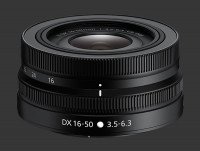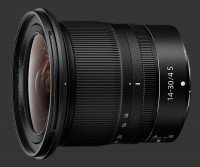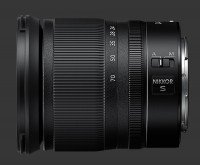Nikkor Z DX 16-50mm F/3.5-5.6 VR Review
Nikkor Z DX 16-50mm F/3.5-5.6 VR
Nikon launched the Nikon Z50
Nikon Z50 packaged with the Nikkor Z DX 16-50mm F/3.5-6.3 VR
Nikkor Z DX 16-50mm F/3.5-6.3 VR as only kit lens available. Given its APS-C sensor with a Focal-Length-Multiplier of 1.5X, this is a slightly wider zoom than most kit lenses, equivalent to 24-75mm on a Full-Frame. Nikon calls these DX and FX format, respectively. Lenses which are not labelled DX are FX, hence compatible with Full-Frame Z-mount mirrorless cameras.
The DX 16-50mm F/3.5-5.6 VR offers an angle-of-view of 83 - 31° which is a general purpose range sufficiently wide for architecture and landscape photography, while just enough for portraits. At wide-angle, its maximum aperture is F/3.5 which is not bright. This narrows down quickly until F/5.6 becomes the maximum starting at 36mm. Such a dim aperture is typical of kit lenses which is why they often are equipped with optical image-stabilization. The incredibly compact Vibration Reduction mechanism in the DX 16-50mm is capable of compensating for up to 4.5-stops of camera shake.
A maximum magnification of 0.2X is possible with the lens zoom in. The optical formulation of this lens gives it a 20cm minimum focus-distance at wide-angle and 30cm at telephoto. Its features a quiet internal focusing system to record video without interference.

Body Design
Compactness is crucial for any kit-lens. Nikon implemented a collapsible to design to minimize size. When closed, the DX 16-50mm F/3.5-5.6 VR measures just 3.2cm deep. This allows the camera and lens to take very little space. It must be expanded before being used which extends an inner barrel out another 3cm. While the zoom mechanism is external, it changes very little the length of the lens from its expanded state. Although this lens offers an 46mm filter-thread, it lacks an additional edge to attach a lens hood, no doubt to save a few millimeters of depth.
The cylindrical body of the Nikkor DX 16-50mm F/3.5-5.6 VR tapers slightly between the fly-by-wire focus-ring and mechanical zoom-ring. By default, the focus-ring acts as Quick-Shift in AF and performs MF. It can also control aperture, which could be useful given that there is only a single control-dial on the Z50, Exposure-Compensation or ISO. This control-ring rotates smoothly and without stops.
The entire front portion of the barrel rotates to zoom. There are hard stops on both ends of the 75° throw needed to zoom from 16 to 50mm. This zoom ring operates smoothly and is slightly textured to enhance grip. Luckily, the inner portion of the barrel which changes length while zooming does not rotate, thus making it practical to use a polarizing filter. Keep in mind that a slim profile is needed to avoid vignetting though.
This kit lens is mostly made of plastic. It appears reasonably well-put together but not entirely sturdy, particularly given it has a plastic lens mount. On the positive side, this DX 16-50mm lens weighs a mere 135g, making it one of the light zoom lenses on the market. Inside, it features a simple 7-blade mechanical iris.

Optical Performance
Sharpness of the Nikkor Z DX 16-50mm F/3.5-5.6 VR is generally weak which is typical of dim variable aperture zoom lenses. Its worst performance comes at wide-angle which shows a soft center with severely blurry corners. By F/5.6, nearly two stops down from maximum, the center is acceptably sharp, while edges become less soft. Corners get slightly less soft at F/9.5, just before diffraction hits. There is never acceptable sharpness at corners near wide-angle.
Around the middle of the zoom range, the entire image from corner-to-corner is almost sharp. The maximum aperture is already a dim F/5.3 at 36mm and stopping further down does not change anything. For some reason, everything gets softer at F/8 and beyond at medium focal-lengths. The telephoto end performs much better. It also starts with the entire image almost sharp at F/5.6 and there is improved sharpness stopping down towards F/8.
Below are 5 crops taken from a photograph, repeatedly captured for each combination of focal-length and aperture. Smaller pieces are cropped from extreme corners of the image, while the middle wide crop is taken from the center of the image. Select an aperture in a row for a desired focal-length to see the crops from the corresponding image. When judging image quality, keep in mind that these crops come from a 20 MP image which is normally used for up to 18x12" prints.
Optical distortion is mild with this lens. There is definitely noticeable barrel distortion near wide-angle but that becomes much more subtle by zooming in a little. The Nikon Z50 always automatically applies distortion correction which is shown in preview, so its impact on framing is taken into account. Vignetting though is severe and there is an option to apply some non-specific correction in-camera. While this is useful, it gets tedious when changing lenses since the setting must be changed each time to match the lens in use.
The builtin autofocus motor of this lens is extremely quiet and can move swiftly, assuming that there is plenty of ambient light. This can become rather slow when shooting towards the long end of the zoom in low-light where the maximum aperture is so dim that the autofocus sensors have little to work with.

Conclusion
One expects a kit lens to be of low-quality since it is practically given away as a starter lens. This time though, there really is no other option. Instead, one can choose to either get the Nikkor Z 14-30mm F/4S
Nikkor Z 14-30mm F/4S wide-angle zoom or the Nikkor Z 24-70mm F/4S
Nikkor Z 24-70mm F/4S to exchange wide-angle for reach. Both these lenses are at least 4X heavier yet vastly superior optically.
Definitely, the Nikkor DX 16-50mm F/3.5-5.6 VR matches expectations of kit lenses. It certainly fares better than many kit lenses Nikon makes for their DSLRs while being substantially smaller and lighter.

Please Support Neocamera
All information on Neocamera is provided free of charge yet running this website is a huge endeavor. Purchases made via affiliate links found throughout the site help keep it running and up-to-date. There is no additional cost to you, so please consider buying via these links to our affilates:
If you found any information on this site valuable and did not purchase via our affiliate links, please considering donating via PayPal:
Any amount will be greatly appreaciated. Thank you for your support!
Updates
2025.01.18

Fujifilm GFX 2025 Lens Roundup
Lens Review roundup of Fujifilm GFX Medium-Format lenses. Quality, performance and handling of the GF20-35mm F/4R WR, GF30mm F/3.5 Tilt-Shift and the GF55mm F/1.7.
2024.11.18

Best 2024 Photography Gifts for Every Budget
Great gifts for photographers and photo enthusiasts selected for every budget among the best products of 2024.
2024.08.07

Eye Protection Tips for Professional Photographers
The four main considerations for professional photographers regarding eyewear.
2024.07.14

Fujifilm X100VI Review
Flagship fixed-lens compact digital camera with a 40 MP sensor and Image-Stabilization, a first for the series. Retro design featuring dual control-dials, plus direct ISO, Shutter-Speed and EC dials. Its hybrid viewfinder can switch between EVF and OVF mode.
2024.05.09

Fujifilm GFX100 II Review
Flagship 102 Megapixels Medium-Format Mirrorless Digital Camera with 8-Stop 5-Axis IBIS, 8 FPS Drive, 8K Video and 400 MP Super-Resolution capture in a weatherproof and freezeproof body with dual control-dials and dual memory-card slots.
2024.04.03

Fujifilm X-T5 Review
Newest Fujifilm flagship boasting a 40 MP APS-C sensor, 5-axis IBIS with 7-stop efficiency, 15 FPS continuous drive, 6.2K Video capture, dual control-dials and dual SDXC UHS-II slots in a sturdy weatherproof and freezeproof body.
2023.11.20

Best Digital Cameras of 2023
Find out which are the Best Digital Cameras of 2023. All the new Mirrorless Digital Cameras from entry-level to high-end professional.
2023.07.10

Fujifilm X-H2 Review
40 Megapixels APS-C Hybrid Mirrorless Digital Camera with 7-stop IBIS. Fastest shutter ever and 8K video capture. Large builtin EVF with 0.8X magnification and 5.8 MP, plus an Eye-Start Sensor. Packed with features and large number of controls in a weatherproof and freezeproof body.
2023.05.07

Sony FE 20-70mm F/4G Review
Review of the unique Sony FE 20-70mm F/4G lens. The optical zoom of this lens spans ultra-wide-angle and medium focal-length coverage, making it one of the most versatile Full-Frame lenses on the market.
2023.01.15

Huion Inspiroy Dial 2 Review
Review of the Huion Inspiroy Dial 2 tablet, a medium sized drawing surface with dual dials and customizable buttons. Connects via USB-C or Bluetooth 5.0 with Windows, Linux and Android support.
2022.12.08

How to Pack for a Photo Trip
Find out how to pack for a travel photography trip, carry your gear safely while meeting airline regulations.
2022.11.13

Best Digital Cameras of 2022
The best digital cameras of 2022. A short list of the most outstanding models in their respective categories. Choose one for yourself or as a gift.
2025.01.18
2024.11.18
2024.08.07
2024.07.14
2024.05.09
2024.04.03
2023.11.20
2023.07.10
2023.05.07
2023.01.15
2022.12.08
2022.11.13
NEWS
2025.03.26

Canon Launches Pair of Cameras and Lenses
Digital Camera ○ Lens
2025.03.25

Venus Optics Launches Vista Vision Cine Lenses
Lens
2025.03.24

Think Tank Photo Walker Pro
Bag
2025.03.20

Fujifilm First Fixed Lens Medium-Format Camera
Digital Camera
2025.02.26

Sony Launches Two New Lenses at CP+2025
Lens
2025.02.25

CP+2025 Showcases Numerous Launches
Digital Camera ○ Lens
2025.02.13

Nikon Launches 5X Full-Frame Power-Zoom Lens
Lens
2025.02.05

Nikon Refreshes Flagship Ultra-Zoom
Digital Camera
2025.02.05

Nikon Launches Ultra-Bright 35mm F/1.2 Prime Lens
Lens
2025.01.21

Fujifilm Evolves INSTAX Wide
Digital Camera
2025.01.16

Leica Launches SL3-S
Digital Camera
2025.01.14

Think Tank Photo Launches Dark Light Tactical Backpacks
Bag


















